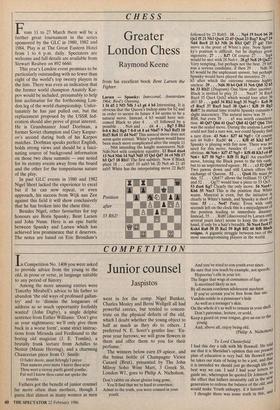CHESS
Greater London Chess
Raymond Keene
From 11 to 27 March there will be a further great tournament in the series sponsored by the GLC in 1980, 1982 and 1984. Play is at The Great Eastern Hotel from 1 to 6 p.m. daily. Spectators are welcome and full details are available from Stewart Reuben on 892 6660.
This year's London event promises to be particularly outstanding with no fewer than eight of the world's top twenty players in the lists. There was even an indication that the former world champion Anatoly Kar- pov would be included, presumably to help him acclimatise for the forthcoming Lon- don leg of the world championship. Unfor- tunately he has just pulled out, but the replacement proposed by the USSR fed- eration should also prove of great interest. He is Grandmaster Josef Dorfman, a former Soviet champion and Gary Kaspar- ov's second during both of his Karpov matches. Dorfman speaks perfect English, holds strong views and should be a fasci- nating source of background information on those two chess summits — one noted for its stormy events away from the board and the other for the tempestuous nature of the play.
In past GLC events in 1980 and 1982 Nigel Short lacked the experience to excel but if he can now repeat, or even approach, his success from Wijk aan Zee against this field it will show conclusively that he has broken into the chess elite.
Besides Nigel, other favourites for top honours are Boris Spassky, Bent Larsen and John Nunn. Here is an epic battle between Spassky and Larsen which has achieved less prominence that it deserves. The notes are based on Eric Brondum's from his excellent book Bent Larsen the Fighter.
Larsen — Spaasky: Interzonal, Amsterdam 1964; Bird's Opening.
1 f4 d5 2 Nf3 Nf6 3 e3 g6 4 b4 Interesting. It is obvious that the Queen's bishop aims for b2 and in order to secure its future 4 b4 seems to be a natural move. Instead, 4 b3 would have wel- comed Black to play 4 . . . c5 followed by a possible . . . Nc6 and . . . d4. 4 . . . Bg7 5 11b2 0-0 6 Be2 Bg4 7 0-0 c6 8 a4 Nbd7 9 Na3 Bxf3 10 Bxf3 ReS 11 d4 Ne4? This natural move does not seem quite correct. White's problem would have been much more complicated after the simple 11 . . Nb6 intending the knight manoeuvre Nc8- Nd6-Ne4 with complete equality. 12 Bxe4 dxe4 13 Nc4 Nb6 14 Na5 Nd5 15 Qel Qd7 16 c4 Nf6 17 b5 Qc7 18 Rbl! The first subtlety. Now if Black plays 18 . . . cxb5 19 axb5 b6 20 Nc6 a6 21 d5 axb5 White has the interpolating move 22 Be5!
Position after 33 Rb2! followed by 23 Rxb5. 18. . . Ng4 19 bxc6 b6 20 Qe2 f5 21 Nb3 Qxc6 22 d5 Qxa4 23 Bxg7 Kxg7 24 Nd4 Rec8 25 h3 Nf6 26 RfcI Qd7 27 g4! This move is the point of White's play. Now Spass- ky's position is difficult, but he displays great ingenuity. 27 . . . Kf7 Of course 27 . . fxg4 would be met with 28 Ne6+. 28 g5 Ne8 29 Qa2!? Very tempting, but perhaps not the best. 29 h4! was a senous candidate, if then 29 . . Nd6 30 h5 would be the unpleasant answer, but perhaps Spassky would have played the inventive 29 . . •
h5 after which the outcome remains highly unclear. 29 . . . Nd6 30 h4 Qe8 31 Ne6 Qh8 32 ti5 h6 33 Rb2! (Diagram) One blow after another. Black is invited to play 33 . . . Nxc4? 34 Rxc4 Rxc4 35 Qxc4 Qxb2 which would lose after 36 d6!! 33 . . . gxh5 34 Rh2 hxg5 35 Nxg5+ KeS 36 c5 RxcS 37 RxcS bxc5 38 Qa4+! Kf8 39 Rg2 Re8?! In mutual time trouble Spassky commits a slight inaccuracy. The natural move was 39 . . • Rb8, but even 39 . . . a5 was worth considera- tion. 40 Qd7 Qh6 41 Qxa7 Qh8 42 Qd7 Qh6 This was the sealed move. During the analysis Larsen could not find a sure win, nor could Spassky find a sure draw. 43 Ne6+ Kf7 44 Ng5+ Of course not 44 Nd8+ Rxd8! 44 . . . Kf8 45 Kh2 IA?! Spassky is playing with fire now. There was no need for this move, besides 45 . . c4 looks obvious. 46 Ne6+ Kf7 47 Ng5+ Kf8 48 Kh3 c4 49 Ne6+ Kf7 50 Ng5+ Kf8 51 Rgl! An excellent move, forcing the Black pawn to the 6th rank, but to an unprotected square. 51 . . . c3 52 Qe6! Two pawns down and still Larsen offers the exchange of Queens. 52 . . . Qxe6 He must do this. 52 . . . Qh8?? allows the brilliant 53 Qf7+ and 52 . . . Qg7? would lose a piece to 53 Qe5. 53 dxe6 Kg7 Clearly the only move. 54 Nxe4+ Kh6 55 Nxc3 This is the position that White wants. Material is even, but the initiative Is clearly in White's hands, and Spassky is short of time. 55 . . . NM? Panic. Even with only seconds left on the clock this is a misjudgment of the position leading to immediate disaster. Instead, 55 . . . Rd8! (discovered by Larsen onlY several years later) seems to keep the draw in hand, if only by a hair's breadth. 56 Nxe4 fxe4 57 Kxh4 Ra8 58 f5 Ra2 59 Rg8 Rf2 60 Rf8 Black resigns. A gigantic struggle between two of the most uncompromising players in the world.














































 Previous page
Previous page